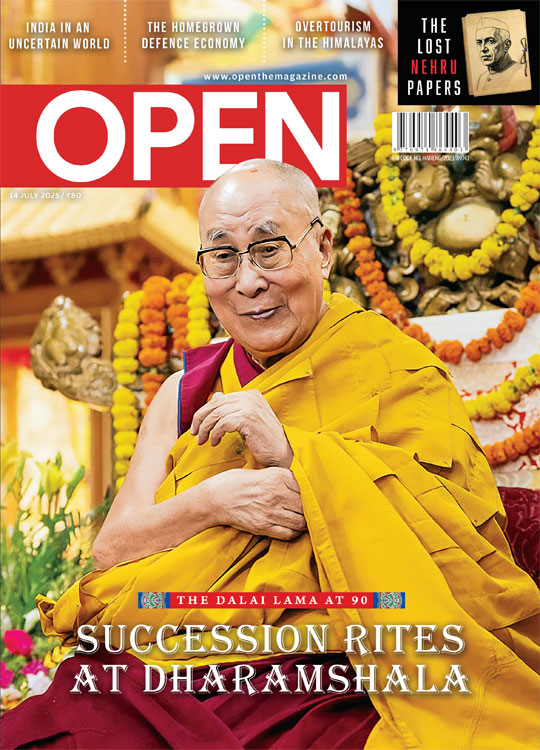Arcot: The Prototype of Divide-And-Rule
The idea of Arcot
/wp-content/uploads/2017/08/Arcot1.jpg)
WHEN THE CURRENT prince of Arcot, Mohammed Abdul Ali, called on Pranab Mukherjee soon after he became President in mid-2012, the Congress veteran and former Union minister welcomed him to Rashtrapati Bhavan with a gleeful remark: “It is because of you people that British ruled India.” Ali didn’t say a word but grinned because he was aware that the President knew his history only too well and also that his ancestors couldn’t have done anything against the mighty British. “They were helpless. They did what they could do,” says Ali, seated in a throne-like chair inside the palace of Amir Mahal, located in Chennai’s Royapettah. “If I were to travel in a time machine, I couldn’t have done much differently from what my ancestors had done,” notes this tall man with regal looks and demeanour, endorsing the historical claim that the Kingdom of Arcot had been a pawn in the hands of the British who not only looted its resources, but also replicated the model of annexation they pioneered in this small town to rule the rest of India. Several local historians suggest that the reason Indians speak English has its roots in Arcot, referred to in Tamil as Aarkaad—now a sleepy semi-urban region along the once full-flowing River Palar (‘river of milk’) which has since dried up—where British traders and militarists tasted first blood: they realised they could do business and also control the country politically through a policy that was destined to become the trademark of British conquest in the Subcontinent, divide and rule.
Of course, the more famous spot that symbolised the beginning of English military expansion and political power in India is Plassey in the erstwhile province of Bengal. It was there on June 23rd, 1757, that British East India Company defeated the Nawab of Bengal, Siraj ud-Daulah, and his French allies, heralding the beginning of the British reign over a country that would soon earn the epithet, ‘jewel in the crown’ of Great Britain. The reasons for this qualifier were manifold: the Subcontinent offered them a wealth of spices and natural resources, a market for its products for which raw materials were sourced from India, easy access to the Indian Ocean and other markets, cheap labour, and so on. Yet, it was at the lesser known Arcot where an experiment for British political designs first began. One of the key military masterminds of the plot in the entire southern region, which back then was called Carnatic, would later lead the Plassey onslaught: Major General Robert Clive. Without his 1751 success in what later came to be known as the 52-day Siege of Arcot, he wouldn’t have acquired the status he possessed six years later when he rewrote the future of India in Plassey, also known as Palashi, then a quaint village and now a bustling town along the Bhagirathi river in Nadia district of West Bengal. Over the next 100 years, as their East India Company expanded their sway across the country, the British would find the colony too irresistible to be controlled indirectly. Historical compulsions would force them to nip the wings of the Company and send civil servants to govern this prized possession.
The Delhi Gate at Arcot stands amid the ruins of what was once the Fortress of Arcot, which was brought under English control by Clive on September 23rd, 1751. He was then a 26-year-old clerk of the Company based in Madras. There is a room once used by Clive atop the wide wall, which watches over the busy highway and the surrounding restive plains. Sudhakar, a caretaker appointed by the Archaeological Survey of India (ASI), knows its history. “Clive’s story begins from here,” he says, noting that besides Muslim pilgrims from afar, only a handful of researchers currently visit this monument. A plaque reminds visitors of the fate-defying triumph of Clive against French forces that backed Chanda Sahib, then Nawab of Carnatic, against his relative and claimant to the post of Nawab, Muhammed Ali Khan Wallajah, who was supported by the British. Ambitious and aggressive, Chanda Sahib, after consolidating his position in Arcot with French military help, had headed to Trichinopoly where Wallajah was then based. He had the blessings of Joseph François Dupleix, the French governor general, and the British loss in the south was seen as a foregone conclusion thanks to their shortage of ammunition and troops.
Clive, equally ambitious and driven, came up with a desperate plan: that he and his team would besiege the Fortress of Arcot and take control of it to demand that Chanda Sahib and his French soldiers withdraw from Trichinopoly in exchange for a British pullout from Arcot, Sahib’s headquarters. Then Madras Governor Thomas Saunders agreed to the plan though he was convinced that it was risky. However, a siege of Arcot was considered a better option than to challenge the powerful French troops at Trichinopoly. Besides, Clive had been associated with the Carnatic Wars of the earlier period and the capture of Devicota under the leadership of Stringer Lawrence, often described as the father of the Indian Army. Clive and Lawrence would later become thick friends.
The garrison town at Arcot, which then had 100,000 residents, easily fell to the British troops led by Clive and his 600-odd men, including close to 200 Europeans and 400 sepoys, as Chanda Sahib’s soldiers abandoned it in panic in the face of the surprise siege. Robert Orme, British historian, quotes from a sergeant’s memories of the incident that Clive marched into the town ‘amidst a million spectators whose looks betrayed them traytors notwithstanding their pretended friendship and dirty presents’. Orme also wrote about how the people there ‘gazed on them’ with admiration and respect as Clive and his men occupied the fortress that had a population of close to 4,000 people, without firing a shot. When Sahib found out about this, he dispatched more than 4,150 men, including French troops, to recapture it. By then Clive had stored water and food supplies for more than 60 days and had distributed land and wealth amassed by Sahib from feudal lords in the area back to the people to win popularity.
After his triumph at the Siege of Arcot, Robert Clive was destined to become the symbol of his country’s military prowess, and later as commander-in-chief of British India, he established the political supremacy of his empire in the Subcontinent
The Fortress that once had a radius of one mile is now in ruins and farther from the Delhi Gate; there now stands a mosque and partially damaged swimming pools, one of the king and the other for the queen. The place is mostly frequented by men who use the property to drink and play cards. Next to the mosque, there is a Hindu site of worship that has come up. “Mostly Muslim men and women come here on special occasions to offer prayers,” says Sudhakar.
Clive refused to surrender despite multiple odds stacked against him, sensing that there could be reinforcements from Madras and help from the Marathas. He also snubbed Raza Sahib, the son of Chanda Sahib, who had led the siege on him for negotiations. Finally, on the 52nd day, in the face of clever British assault, Raza had to withdraw his troops to the nearby Vellore and leave behind arms and ammunition.
The main wall of the Arcot Fortress was named Delhi Gate to indicate an intent to conquer Delhi, then under the Mughal Dynasty which was more or less in its death throes. The rest of the fort, built in 1698 by Daud Khan Panni, Nawab of the Carnatic, later the viceroy of Deccan and a protégé of Mughal Emperor Aurangzeb, was destroyed in invasions over the next centuries.
WITHOUT DOUBT, THERE were numerous extraneous factors that contributed to the rise of British East India Company’s political power in India, the most important being the decline of the Mughal Empire following the death of Aurangzeb in 1707. Nirad C Chaudhuri, chronicler of the rise of British India, has written that ‘the general pattern of dynastic politics at the centre of Mughal power in Delhi was repeated in all provinces where the Muslim governors became independent or semi-independent’, referring to princely states such as the Carnatic that owed allegiance to the Mughals. He also notes that the power of these dynasties often ended with the death of the first ruler, suggesting that they were vulnerable to meddling by outsiders. Chaudhuri has often stated a remarkable aspect about the Mughal Empire, the fall of which led to the rise of the British Empire. Writes he: ‘Strangely enough, the power of the Mughal Empire lasted only as long as the period of effectiveness assigned to a dynasty by the Muslim historian Ibn Khaldun, the first proponent of a secular philosophy of history. Writing in the fourteenth century, he set down the general law that no dynasty could enjoy power for more than three generations, or 120 years. He arrived at this conclusion by studying the history of all Muslim dynasties from the age of the Caliphate to his times.’ Chaudhuri had argued that the real power of the Mughal Empire didn’t last more than that period by assessing the five stages that Khaldun had noted of an empire: ‘the growth in which the conquistador is identified with his people, adherents, and helpers; second, of successful consolidation…; the third, leisure and tranquillity…; the fourth of contentment and peace; and the last of waste and squandering.’
CHAUDHURI, IN HIS stellar work, Clive of India: A Political and Psychological Essay , offers great insights into the period after acknowledging the importance of Arcot and Clive to the making of the British India: ‘The gradual infiltration into Indian politics was not only made possible by circumstances, but also by the presence on the spot of certain persons at decisive junctures. When the man was not matched to the hour, that is to say, when the type of individual who was ready to exploit a tempting situation or act defiantly to meet a dangerous one was absent from the scene, the process did not make headway.’ The controversial Anglophile who died aged 101 in 1999 in the UK went on to state in the rigorously researched book, with nearly incontestable logic and arguments, that he was the closest in British history to a type to which Napoleon belonged.
The first Nawab of Carnatic was Zulfikar Ali Khan, named to the position in 1690 by Aurangzeb. In 1855, his descendants, the Arcot family, lost the title of Nawab when the British abolished the post on account of the Doctrine of Lapse
Even if Orme or Chaudhuri are to be taken with a pinch of salt, Clive clearly ended up being the symbol of his country’s military prowess and cunning, and as commander- in-chief of British India, he established the political supremacy of his empire in the Subcontinent with an iron fist. In the process, he also struck gold through dubious ways. He suffered huge personal reverses towards the end of his life with rivals back in Britain attacking sharply his finances, and died aged 49.
But as historians confirm, he was the one who arguably made the single-most important contribution to ‘politicising’ the East India Company, an act that more than a 100 years later led to the establishment of the British Raj in 1857 after the First War of Independence—which resulted in direct British rule of India. The process started in Arcot. Historian A Mervyn Davies writes in his comprehensive biography of the general, Clive of Plassey, that his success was thanks to his military vision that defied conventional ways and his knowledge of the Indian mindset. He writes, ‘…Clive demonstrated his lack of regard for the ordinary axioms of war and his equally keen perception of the way in which success could be attained in the unique circumstances of this Indian warfare, where numbers counted for much less than morale.’ This was evident in Bengal as well where military acumen was favoured by good luck. Nicholas B Dirks writes in The Scandal of Empire: India and the Creation of Imperial Britain that ‘… the battle (of Plassey) itself, seen by many as evidence of Clive’s military genius, was in fact a near disaster, saved in the end only by the early death of one of Siraj- ud-Daula’s most trusted generals and the late but crushing defection of Mir Jafar.’ Jafar later became the Nawab of Bengal.
For the rulers of Arcot, Bengal and elsewhere, accepting British support also meant accepting their hegemony. Similar tactics of annexation and control would soon be played out all across the Subcontinent and beyond. Interestingly, while the policy that involved offers of military support to kingdoms across the country in return for money and occasionally land was initially successful, exorbitant levies slapped on kingdoms and fraudulent treaties that were sheer debt traps for many princely states would result in resentment and later revolt. Such events also marked the rise of early nationalism in India.
In the 1850s, as reported in the British media then, Lord Dalhousie, then Governor General, had wanted to reduce dependence on native armies and had brought kingdoms directly under British rule. Under the Doctrine of Lapse, any princely state under the British East India Company would be annexed if the king or nawab was either inefficient or without a son as heir. This policy led to the annexation of Oudh in 1856, resulting in, as reported in The Spectator, a sense of grievance not only among grandees like Nana Sahib and the Rani of Jhansi, who lost status and income, but also in the ranks of the Bengal army itself, which was largely recruited in Oudh. After rebellion broke out, starting with the attack of a British sergeant by Indian soldier Mangal Pandey in Barrackpore, the British Parliament took a step backwards, and in a neat ruse, withdrew the right granted to the Company to rule India and in 1858 appointed a Governor General to take direct charge. Thus began the British Raj, which would also, unsurprisingly, pursue the strategy experimented to the hilt in Arcot.
Writing on July 15th, 1857, in the New York Tribune, Karl Marx wrote about the revolt in the Indian Army. He noted that the Roman ‘Divide et impera’ was the policy by which Britain extended its pre-eminence in India. ‘The antagonism of the various races, tribes, castes, creeds and sovereignities, the aggregate of which forms the geographical entity of India, continued to be the vital principle of British supremacy.’ Marx had also stated in his essay that Britain would find it increasingly difficult to hold its own forever by relying on native armies even if it continued to divide people along religious lines, a forecast, that in 2007, would invite praise from Christopher Hitchens who applauded Marx as ‘the heretical exile who believed that India would one day burst its boundaries and outstrip its masters’. Exploitation of rivalries would endure to the days of Winston Churchill, who had declared that Hindu-Muslim enmity would remain “a bulwark of British rule in India”.
On the other hand, despite robbing India of its wealth, Britain truly believed that it was meant to civilise India and put the country on a road to modernisation, an argument that is held true even now by conservative historians such as Niall Ferguson. ‘Without the spread of British rule around the world, it is hard to believe that the structures of liberal capitalism would have been so successfully established in so many different economies of the world,’ Ferguson writes. Whether you agree with him or not, in India it started in Arcot.
ON THE WAY to Arcot from Chennai—the 114-odd kilometres that Clive had taken some 266 years ago on his way to capture Chanda Sahib’s fortress in a fit of rage over dwindling English prospects in the south—you are served excellent coffee on roadside eateries these days. Kumbakonam Degree Coffee tastes of chicory, and is said to be prepared from unadulterated coffee and cow’s milk. A late morning drive takes you to Arcot just in time for lunch and the most famous item on the menu is Aarkkad biryani, which like Thalasseri biryani of the Malabar region, is made from small-grained jeeraka samba rice, quite unlike other biryani that use long-grained rice. The mouth-watering Arcot makkan peda, a sweet dish, is best eaten after a hearty biryani meal.
“We live in modern times, but Arcot is known for its Nawabi food varieties because we used to have a lot of influence of Nawabi habits here. The British came and tried to change all that, but food habits, as you know, don’t go away,” says Muhammed Amin, who runs a restaurant in town. His simplistic explanation perhaps captures what he says he has learnt in history: that the Nawabs of Arcot became vassals of the East India Company and later the British Raj after one of them—who wanted to unseat another of his own blood—took the help of Clive’s troops. Over time, East Indian Company officials became better known for their corrupt ways, and Arcot’s Indian grandees found it tough to service debts to the company which continued to fleece them of resources and wealth.
Mohammed Abdul Ali, the prince of Arcot, explains that his family traces its lineage all the way to Caliph Omar (579- 644 CE). It was Zulfikar Ali Khan, one of his ancestors, who was first named the Nawab of Carnatic by Aurangzeb. Later in 1855, the family lost the title of Nawab when the British abolished the post on account of the Doctrine of Lapse. Later in 1867, the British conferred the title of ‘prince’ on one of the male members of the family, Azimjah Bahadur. “That was a humiliation, but that is the reason why I am still able to hold this title,” says Ali. In fact, he is the only Indian who is officially a prince in the country. The abolition of Privy Purses in the early 1970s didn’t cover the prince of Arcot. In an answer to a question in Parliament on June 19th, 1998, then Home Minister LK Advani confirmed the prince of Arcot didn’t fall under the Constitution Amendment Act of 1971. This was to a question raised by the late KR Malkani, then a member of the Rajya Sabha.
Ali, son of Ghulam Mohammed Abdul Khader, is proud of the philanthropic activities his family had done over centuries to promote art and education. “I continue the efforts. We have close to 600 people who live on the campus, whose families have served the royal family for generations,” he says, serving me a mutton cutlet from among various delectable dishes on the high table in a spacious room filled with portraits of yore. As I walk out an hour later, I notice a painting in which one of the Nawabs of Carnatic is seen shaking hands with Stringer Lawrence, Clive’s superior officer.
That was much more than a handshake.

/wp-content/uploads/2025/07/Cover_Dalai-Lama.jpg)















More Columns
The US$4 Trillion Monopoly Madhavankutty Pillai
Elite Socialism vs. Old Fashioned American Hustle: New York’s Mayoral Showdown Vikram Zutshi
From Manipur to Global Glory: John Gwite rides 3,600 km to set new Indian record at World Ultra-Cycling Championships Open